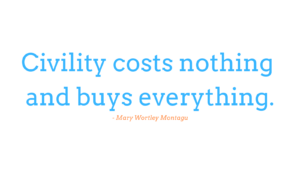Barks Blog
The Lost Art of Disagreeing Without Being Disagreeable – An Urgent Need

By Niki Tudge
As business owners, one of our fundamental responsibilities to our clients, our employees and our stakeholders is to ensure that we provide a workplace where civility is not only a priority, but a deep-rooted, daily cultural norm. Manners, respect, consideration, tolerance and equality are all characteristics and indicators of a healthy and progressive organizational culture. While the mere suggestion of implementing a workplace training program on manners may draw sneers and seem like overkill, the reality is that rudeness is a workplace epidemic that can cost small businesses millions each year in lost revenue, high staff turnover and poor public relations.
One of the growing culprits here is the gains that have been made in both knowledge advancement and technology. Forni et al. (2003) speaks to more flattened organizations where relationships are now less formal and more casual. This resulting lack of structure can create work environments with fewer social norms and a loss of civil behavior.
As such, people may sometimes “lose” some of their basic social values, and this can have a detrimental impact on our own businesses, private lives and family infrastructure. For example, employers may rudely intrude on an employee’s personal workspace; gossiping coworkers may become the norm; and quality customer care can get lost through keyboard warrior relationships and the virtual realms in which we often find ourselves operating. Much of this may lead to a work environment that is no longer conducive to productive relationships or highly functioning workplace teams.
As business owners, employers and/or workplace colleagues, we need to understand how to effectively practice civil behavior and implement boundaries. This applies across the board to our managers, our coworkers and our subordinates. This will help us prevent uncivil workplace cultures where harassment, intimidation and unhealthy stressors are fodder for individual behaviors that can negatively impact organizational structure.

Seemingly innocuous behaviors like failing to smile at a colleague, smirking at another person’s suggestion, gathering in small clans or cliques, or ostracizing others through exclusionary practices can be very costly to employee morale, team-building efforts and employer trust. There are few companies that have truly prospered when these types of behaviors have gone unchecked in the workplace. It is important, then, for each of us to rekindle a civil disposition, and it should become imperative to practice this within our own work organizations. Our behavior in society in general should be governed by these very same principles. I dare say we have all experienced passive-aggressive, rude, if not hostile behavior from others at some time in our working lives. Others among us may fall victim to this in our private lives.
Antoci et al. (2016) describe a research project conducted by the Pew Research Center that documented the growth in incivility across social networking sites. Their findings included the following:
- 73 percent of online adults have seen someone being harassed.
- 40 percent of online adults have personally experienced harassment.
- 49 percent of online adults have seen other users behaving cruelly.
- 60 percent of online adults have witnessed someone being called offensive names.
- 53 percent of online adults had seen efforts to intentionally embarrass someone.
In the Baltimore Workplace Civility Study (Forni et al., 2003), a survey conducted online, adults were questioned about workplace bullying to determine the frequency. Bullying was defined as the deliberate, repeated, hurtful verbal mistreatment of a person (target) by a cruel perpetrator (bully). I was particularly surprised by the survey findings initially, yet on reflection these results made sense to me given my own experiences with uncivil and overly aggressive and hostile women. The findings revealed that women bully as frequently as men (there was a 50 percent split). Within that, 84 percent of the time women tend to target other women, whereas men target women 69 percent of the time.
What Is Civility?
Workplace civility can be defined as “behaviors that help to preserve the norms for mutual respect in the workplace; civility reflects concern for others” (Andersson & Pearson, 1999).
We all operate within our own subcultures, so this definition refers to the attitudes and patterns of behavior across a specific group. Social norms are the attitudes and behaviors the group deems to be acceptable, typical or average. Civility represents these norms and the rules the group determines should be followed so we can productively relate to each other. The rules may consider respect, tolerance, courtesy and consideration as the foundation to civility supported by a rational approach to identifying and resolving conflict. Therefore, any behavior that challenges these norms or threatens the development of productive relationships can constitute uncivil behavior. In some situations, you can be perceived as being uncivil even though the individual motivation and intent are missing.
As a reader, you may be thinking that you are not an uncivil person, that you do not behave in a way that is bullying or harassing or intimidating to others. But do you?
Common behaviors that are considered uncivil include:
- A failure to notice or acknowledge another person’s presence, such as ignoring them in a group situation or their arrival to a group setting.
- Ignoring a person’s greetings or well wishes as they approach or leave our company.
- Bullying or behavior in the form of leveraging the power of cliques to ostracize particular individuals.
- The use of hostile, intimidating or crude language towards or about something or somebody.
- To either gossip or spread gossip about another, irrespective of its factual accuracy.
- Surreptitiously assigning blame to a third party for a workplace mistake based on unclear expectations, particularly if this mistake or person is then a topic of gossip.
- Sabotaging an individual’s performance through lack of communication or support.
- Ignoring or downplaying an individual’s contribution in the workplace or on a project.
- Being insensitive to others’ needs with regard to personal time off, support or tolerance.
- Poor communication etiquette, such as ignoring calls or emails, omitting to reply to some team members over others. Remember, civility is beyond just good manners.
- Visual or verbal bullying: this is not only uncivil but can also be illegal.
- Behavior that discriminates against an individual because of an intrinsic characteristic or physical appearance: this is not only uncivil and immoral, it can also be illegal.
Some of the examples above are very clear cut. Bullying, harassment and intimidation will not only be an infraction of workplace conduct policies, resulting in disciplinary action or termination, but those guilty may also find themselves in legal hot water as they can also result in arrest and even, indeed, imprisonment.
Exclusionary Practices
What, though, about some of the more subtle uncivil behaviors, like the development of cliques and exclusionary practices? These behaviors may be overlooked by leadership and management, yet there are compelling arguments for workplace policies that ensure that good manners, respect, tolerance, courtesy and consideration are applied and practiced by everyone.
Civility encompasses both a self-awareness and social awareness. It is just not possible to be civil without recognizing who you are and how your behavior impacts others. We must balance our own needs with the needs and contributions of those around us, whatever position we hold in an organization. We have a responsibility to ourselves and the team we are members of to consistently behave with professionalism and civil conduct.
Humans are naturally social beings. We need to interface with others and live in social groups, communities and families. Even if you consider yourself to be something of a superstar—a fabulous, indispensable workplace contributor—don’t be fooled. Each of us is just one part of a supply chain, or the workplace process—a chain of activities that needs input from lots of different team members for the company to successfully produce its services or products. Avoidance of people is not a solution. Believe me, I have tried! In our lives, our professional work and with our families, there is just no avoiding social and professional contact with other members of our species. In the workplace, without interacting productively with others in this chain of activities, you cannot execute your own job responsibilities effectively. Doing this fully requires productive and trusting relationships governed through civility and social norms.
If you find yourself frustrated at work or find your workplace scattered with damaged or stressful relationships, you may want to take a hard, reflective look at how you behave towards others and the impact your behavior has on those around you before looking outward for others to blame.
What’s in It for Me?
Civility is a form of benevolent participation and there are so many benefits to practicing civil behavior. For those of you asking, “What’s in it for me?” There is plenty!
As a general workplace note, being civil helps create a positive working environment with your peers. There is nothing better for workplace morale and confidence when we work with others who treat us with respect and support in our endeavors. Colleagues who we trust not to gossip about us, be verbally confrontational or sabotage our efforts have a huge impact on both our performance and the team’s output. On the flip side of that, when we are exposed to or contribute to a work environment where there is a lack of respect and we fall victim to any kind of bullying or harassment, however low level it may appear to be, this impacts our feeling of self-worth and our ability to perform our jobs.
Practicing civility helps teach us emotional intelligence, so we can develop the competencies and ability to recognize our behaviors, moods and impulses. When we are more self-aware, we are better at managing ourselves in various situations. Civility helps us develop anger management skills and become more resilient and less frustrated when we face workplace obstacles. As self-aware, productive individuals in the workplace, we will also develop better skills at managing uncivil behavior. We can learn how to communicate honestly, manage conflict and differences, negotiate positive outcomes and benefit from more productive relationships.
Being civil is also the right thing to do. Most religions, philosophies and individual belief systems advocate consideration of one’s fellow person. To quote Richard Boyd, associate professor of government at Georgetown University in Washington, D.C., “To fail to be civil to someone—to treat them harshly, rudely or condescendingly—is not only to be guilty of bad manners. It also, and more ominously, signals a disdain or contempt for them as moral beings.”
Andersson and Pearson (1999) express it well. They explain that some scholars and social critics believe people support an ethic of self-expression and detest the pretense of civility because they believe it denies their desire for freedom and individuality. Indeed, I believe a fundamental responsibility we all share as part of our individual freedom is to treat all others with civility and kindness. What say you?
References
Andersson, L.M., & Pearson, C.M. (1999, July). Tit for tat? The spiraling effect of incivility in the workplace. The Academy of Management Review, 24(3), 452-471. https://doi.org/10.2307/259136
Antoci, A., Delfino, A., Paglieri F., Panebianco, F., & Sabatini, F. (2016, November). Civility vs. incivility in online social interactions: An evolutionary approach. PLoS ONE, 11(11), e0164286. https://doi.org/10.1371/journal.pone.0164286
Forni, P.M., Buccino, D.L., Greene, R.E., Freedman, N.M., Stevens, D., & Stack, T. (2003). The Baltimore Workplace Civility Study. University of Baltimore, Jacob Francis Institute. Available at: bit.ly/2EAd484
This article was originally published in the March 2018 issue of BARKS from the Guild: Tudge, N. (2018, March). An urgent need for a return to civility. BARKS from the Guild, 29, 56-58.
 Niki Tudge – MBA, PCBC-A, CABC, CDBC SSA-CFT, Six Sigma Black Belt, HCITB TS1, TS2 & TS3
Niki Tudge – MBA, PCBC-A, CABC, CDBC SSA-CFT, Six Sigma Black Belt, HCITB TS1, TS2 & TS3
Niki is a certified dog behavior consultant and holds reputable health and fitness certifications.
As the founder and president of the Pet Professional Guild, DogNostics Education, and The DogSmith, Niki has substantial leadership experience in the pet industry. Niki has published numerous articles on dog training and behavior, and her pet dog training businesses have been featured in many publications, including The New York Times.
Niki’s professional credentials include AABP-Professional Dog Trainer, AABP-Professional Dog Behavior Consultant, PCBC-A and PCT-A through the Pet Professional Accreditation Board. Niki also earned diplomas in animal behavior technology and canine behavior science and technology through the Companion Animal Sciences Institute.
Along with Niki’s business degree and MBA from Oxford Brookes University, she is also a certified Six Sigma Black Belt, an HCITB TS1, TS2 and TS3 certified people trainer, and a certified team facilitator and project manager.
To complement Niki’s dog behavior skills and experience, she is also a certified fitness instructor and walking and running coach, and she carries several certifications in the health and fitness industry. Additionally, Niki offers coaching and fitness programs through her Run With Your Bestie business.
Her professional credentials include International Sports Science Association (ISSA) Certified Fitness Trainer, ISSA Certified Transformation Specialist, ISSA Nutrition Coach and ISSA Elite Trainer. Niki is also a certified ChiWalking and ChiRunning coach. In addition, she has completed the well-known M.A.F. Foundations certificate course developed by Dr. Phil Maffatone and is a supporter of the M.A.F. system.
